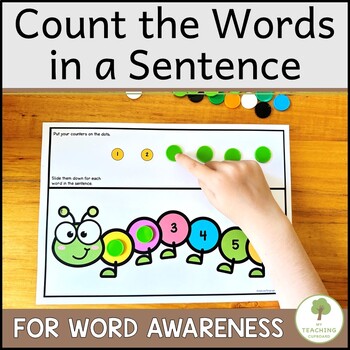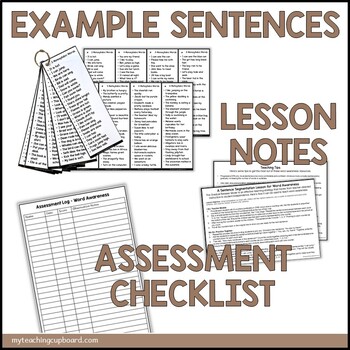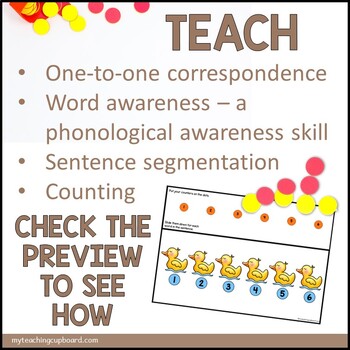Counting Words in Sentences for Sentence Segmentation and Word Awareness
- PDF
Description
Teach word awareness with these sentence segmentation word counting mats and example sentences. Counting words in sentences is the first level of phonological awareness. This resource makes teaching it super easy.
Your students will learn the concept of a word and know that sentences are made up of individual words in no time.
Phonological awareness is about understanding and manipulating the sound structures of our spoken language. It is an auditory and oral language skill, so there are no written sentences for the children to read in this activity.
THIS RESOURCE CONTAINS:
- 10 word counting mats.
- 84 sentences organised in a progressive list ranging in length from 3 to 6 words per sentence. The words in this easier set of sentences consist of only monosyllabic words.
- 60 sentences organised in a progressive list ranging in length from 3 to 6 words per sentence. The words in this second, more difficult set of sentences, consist of a combination of monosyllabic and multisyllabic words.
- A simple lesson plan and teaching notes.
- A teacher checklist to track students' progress and understanding of word awareness.
- A document wallet label to print and help you keep the resources organised.
To teach word awareness, start with simple 3-word sentences with monosyllabic words. Don’t worry – there’s a progressive list of 144 sentences to guide you in this resource.
CHECK OUT THE PREVIEW TO SEE SAMPLES OF THE COUNTING MATS AND SENTENCE EXAMPLES
The length of your sentence and the number of syllables in your words affect how difficult sentence segmentation is for students. That’s why I have included a progressive list of sentences, teaching tips and step-by-step lesson steps.
There are even differentiation ideas, so you can use this activity for literacy intervention or extension.
Make learning hands-on if you want it to be engaging and keep students on task. I have designed these word-counting mats to be used with manipulatives like blocks or counters.
Students will represent the words in each sentence with concrete items. The printable mats help young students to represent or count the words in each sentence.
Resource Objective: Using manipulatives as visual aids, children will hear spoken sentences, use a counter to represent each word of the sentence, and count the number of words in the sentence.
CHECK OUT THE PREVIEW TO SEE HOW EASY COUNTING WORDS IN SENTENCES CAN BE
DIFFERENTIATED
For Intervention: If your child’s performance is inconsistent, use two-word and three-word sentences until the concept is understood. Use the lesson script and the structured steps consistently.
For Extension: To extend their understanding of word awareness, say one of the included sentences with a missing word and ask your students to fill in the blank. For example, A ___ is a pet. This encourages children to think about the structure and meaning of the sentence. An oral cloze activity is great for consolidating the concept of a word.
I know I said it already – I even put it in bold and uppercase – but seriously! Check out the preview to sneak a peek at these word awareness resources!
Want to be notified about product updates and new listings?
CLICK HERE to follow my store on TpT
Stay in touch with My Teaching Cupboard
And HERE on my blog





